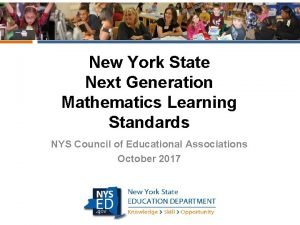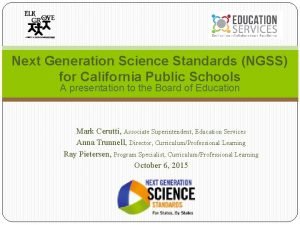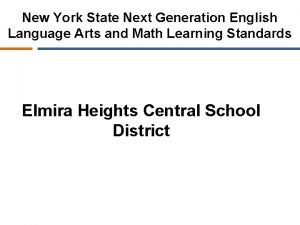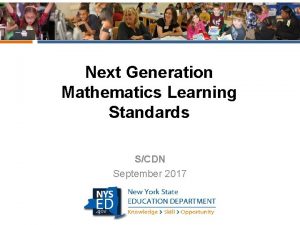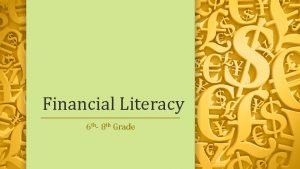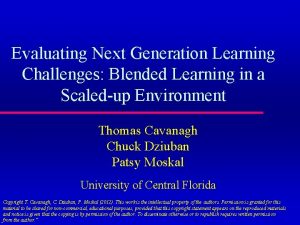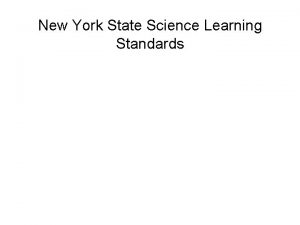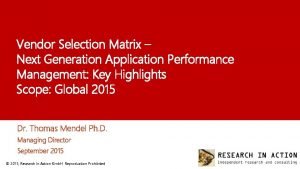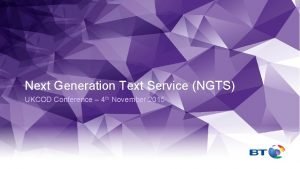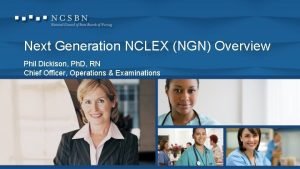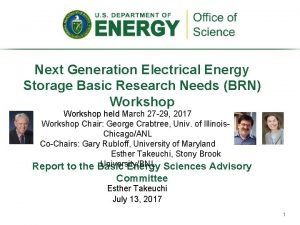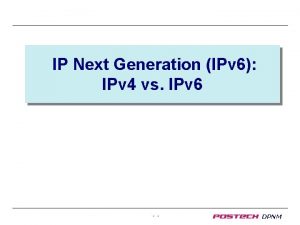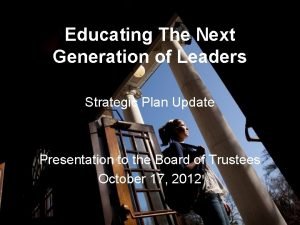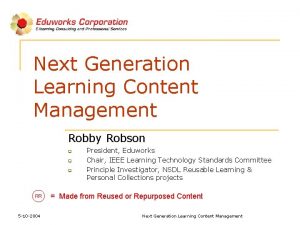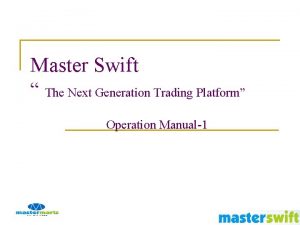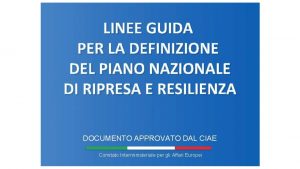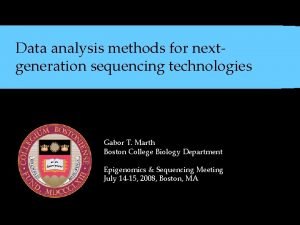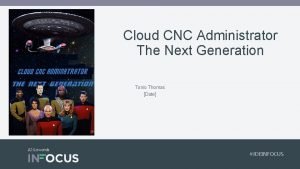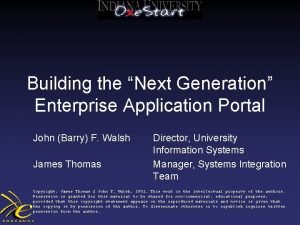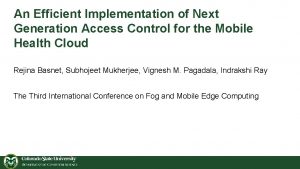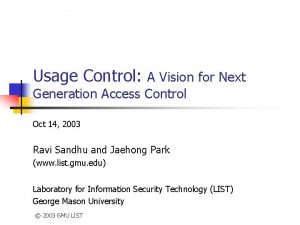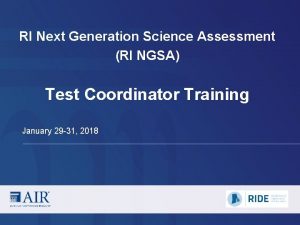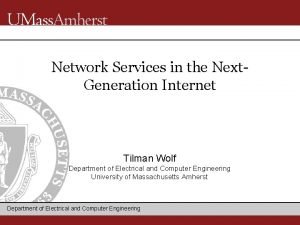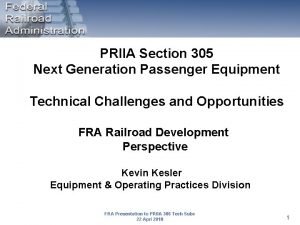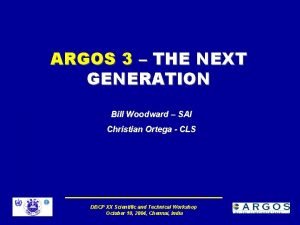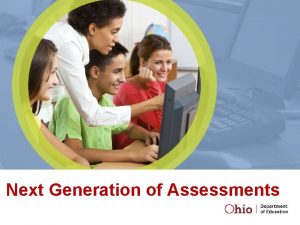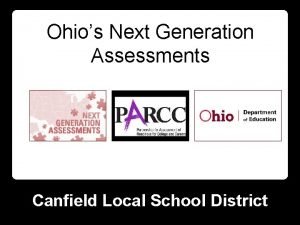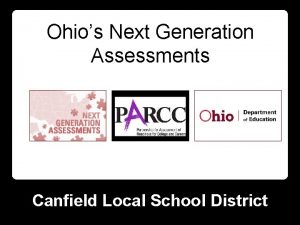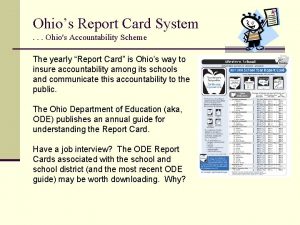Ohios Next Generation Assessments and New Learning Standards

























































- Slides: 57

Ohio’s Next Generation Assessments and New Learning Standards - Meeting the Needs of Diverse Learners Pupil Services Directors Meeting Dec. 13, 2013

Char Shryock Director of Curriculum and Instruction Bay Village City Schools Ohio Education Leader Cadre char. shryock@bayschoolsohio. org Twitter @edtechgirl #PARCCELC, #ohedchat http: //iteachbay. blogspot. com

PARCC Update Understanding PARCC’s Role In Ohio’s Next Generation Assessments

PARCC’s Fundamental Advance PARCC is designed to reward quality instruction aligned to the Standards, so the assessment is worthy of preparation rather than a distraction from good work.

Show me the EVIDENCE Think of examples of why EVIDENCE is such a relevant word in education today.

Evidence Centered Design can inform a deliberate and systematic approach to instruction that will help to ensure daily classroom work leads to all students meeting Ohio's New Learning Standards.

Evidence-Centered Design (ECD) in the Classroom - Start with the end in mind. PARCC is using ECD to create the gr 3 -11 assessments. Learning Targets/Objectives Design begins with the inferences (claims) we want to make about students—should be connected clearly to Ohio's New Learning Standards - What should students be able to DO or KNOW? Classroom Assessments Formative/Summative In order to support claims, we must gather evidence----what can teachers point to, underline or highlight to show that students are making progress toward doing what we claim they can do? Classroom Activities Classroom activities (tasks) are designed to elicit specific evidence from students in support of claims.

Understanding the Claims


Prototype Questions

PARCC Assessment 101 ELA Performance ELA End of Year Exam Based Assessment (EOY) (PBA) ❖ Research Simulation ❖ Include 4 -5 texts both Task Info and Literary ➢ Short answer ❖ Literary Analysis Task comprehension ❖ Narrative Task questions Read Multiple Texts ➢ Focus on comprehension using vocab and short answer questions ➢ Write an evidence ➢ Vocabulary questions ➢ Info text will be science, social studies, technical ➢

PARCC Assessment 101 Math Performance Based Assessment (PBA) ❖ Short Response ❖ Extended Response Focus on mathematical practices ➢ applications of skills and practices to solve problems focusing on modeling, reasoning ➢ Math End of Year Exams (EOY) ❖ Short answer questions Focus on conceptual understanding ➢ Focus on procedural skills ➢ Focus on application ➢

Performance Level Descriptors PARCC will report students achievement using PLDs and scaled scores. In October 2012 PARCC established 5 performance levels • Level 5: Students performing at this level demonstrate a distinguished command of the knowledge, skills, and practices embodied by the Common Core State Standards assessed at their grade level. • Level 4: Solid command… • Level 3: Moderate command… • Level 2: Partial command… • Level 1: Minimal command… • Cut Scores will be determined in the Summer of 2015 using multiple stakeholders in the decision making process.

Looking at the PLDs Gives the PLD by performance level ranging from 2 -5. Level 1 indicates a range from no work shown to Minimal command Gives the Sub-Claim that the PLD is written for (A-Major Content) Gives the Conceptual Concept the PLD is based on

Communicating Around Ohio’s Next Generation Assessments and New Learning Standards. Closing Information Gaps - Teachers, Parents, Community Members

Ohio’s New Learning Standards ● English, Math - from CCSS with input from OH Teachers ● Science, Social Studies, Physical Education, Fine Arts and World Languages - Ohio Developed What you need to know: ● Building a “Toolkit” of Knowledge to make sure students will have choices when they graduate from HS ● Age appropriate ● Aligned across grade levels ● Focus on deeper understanding and real world applications of knowledge. ● All students have access to challenging material ● Focus is on content knowledge AND problem solving, perseverance, supporting opinions and ideas with evidence, modeling, reading and writing, speaking and listening skills.

Ohio Academic Content Standards - Extended Grade Level Standards - By Band

Ohio Academic Content Standards - Extended Grade Level Standards - By Entry Point


Achievethecore. org



All teachers are teachers of language. The language of math, science, social studies, art, business, physical education. If your students are not fluent in your "language" they will not be able to understand your content at a deeper level.


Stanford Research on ELL - Can Help Us Support Our Developing Readers • Differentiate within the ELA Literacy standards by looking at levels of analyses of complex texts. Develop formative assessments around: Analytical Task Expectations o Receptive Language Functions o Productive Language Functions o • Helping students to "decode" learning target verbs - by paying attention to the language conventions tied to the verb.

CCSS and Literacy • Text Complexity Qualitative - levels of meaning or purpose, text structure, language clarity, knowledge demands. (reader measured) o Quantitative - word length, sentence length, text cohesion. (machine measured) o Matches Reader to Task - reader motivation, reader knowledge level, reader experiences, and purpose and complexity of the task. (teacher measured) o

CCSS and Literacy • Writing Argument - change readers point of view, promote reader to take action or convince reader to believe explanation of issues or problems. o Informational/Explanatory Writing - conveys accurate information to build reader understanding or comprehension of a topic. o Narrative Writing - shares real or imagined experiences. Has multiple purposes. o

CCSS and Literacy • Vocabulary Students need to have repeated exposure to content vocabulary in a variety of contexts in order to master the vocabular. o Tier 2 Words - general academic words that are found across multiple content areas. o Tier 3 Words - domain specific words - or academic words that have a unique meaning in a specific content area. Usually need to be defined by the text or the teacher. Students need to know these to "unlock" the content. o

What is DIFFERENT about Common Core Vocabulary Instruction. Traditional - Memorize lists. Use words in sentences. Look up words, copy definition. Study on words and definitions using flashcards. Common Core - Understand recognize words in context. Use the words to make sense of reading. Look at word relationships and build meaning from using context clues and background knowledge. Use words to communicate effectively.


Making The Shift - Literacy • • • How are lessons focusing on helping students to acquire vocabulary. . . in context. . . in all content areas? How are a variety of fiction, non-fiction materials and primary source materials that create a continuum of complex texts for student reading be used. . . in all content areas? What strategies/tools are available to help students build and organize knowledge. . . in all content areas? How are engaging writing prompts that allow students to write persuasively or support an argument being used. . . in all content areas? What opportunities are there to go back into the reading materials to find information to support a discussion. . . in all content areas? What opportunities to work with a group to build reading comprehension by listening to and commenting on the arguments and reflections of others are included. . . in all content areas?

EQu. IP/Quality Rubric - Ohio • • • Rubrics will be used to evaluate exemplar unit plans shared through the ODE website Rubrics will be available to teachers and teacher teams to use when planning lessons/ units. Math, Science, Social Studies, ELA



Communicating to Parents • Most interested in assurance that their students are learning what they need to know to be successful in college or careers as they grow into adulthood, how much it will cost them in increased student fees or tech costs, how students will be assessed, how teachers will communicate learning progress, what they can do at home to support students, how will classroom technology be used safely and equitably. • PTA Parent Guides for ELA/Literacy and Math • PARCC Accommodations Guide For Parents • ODE Parent Portal • Provide District Updates on Curriculum Alignment

Communicating To BOE and Community BOE Members - costs to the district and state, how to budget for teacher training, curriculum changes and technology upgrades, how to balance/respond to opposing viewpoints around adopting the standards, setting aggressive but achievable timelines for implementation, how to increase accountability for student learning - teachers and administrators. Community Members -most interested in cost to the community, maintaining local control over curriculum decisions, supporting a quality educational system to keep home values up, schools preparing students to be active members of the community. NSPRA Common Core Communications Network BASA Updates Twitter Chats - #ohedchat Tues. 9: 00 #oheducation, #PARCC Provide Regular District Updates • •

PARCC Accommodations

Goals For Promoting Student Access • • Using Universal Design principles during every stage of the development process. Minimizing/eliminating features that are irrelevant to what is being measured so all students can accurately demonstrate their knowledge and skills. Measuring the full range of complexity of the standards. Leveraging technology for the accessible delivery of assessment. Building accessibility throughout the test itself without sacrificing assessment validity. Using a combination of ‘accessible’-authoring and accessible technologies from the inception of items and tasks. Engaging state and national experts throughout the development process through item review, bias and sensitivity review, policy development and review, and research.


Accessibility Features for All Students Audio Amplification Blank Paper - math or ELA (provided by test administrator) Eliminate Answer Choices Flag Items for Review General Administration Directions Clarified (by test administrator) General Administration Directions Read Aloud and Repeated (by test administrator) Highlight Tool Headphones Magnification/Enlargement Device (up to 400%) Note. Pad Pop-Up Glossary Redirect Student to Test (by test administrator) Spell Checker

Testing Site Accommodations Based on the PARCC Test Administration Manual the following can be made available to any students based on building admin decision. ❖ Small group testing ❖ Frequent breaks ❖ Time of day ❖ Separate or alternate location ❖ Specified area or seating ❖ Adaptive and specialized equipment or furniture

Proposed Accommodations for Students with Disabilities and ELL Students

Universal Design Principles “It is important to ensure that performance in the classroom and on the assessment is influenced as little as possible by a student’s disability or linguistic/cultural characteristics that are unrelated to the content being assessed. ” ❖ Provide equitable access during instruction and assessments ❖ Mitigate the effects of a student’s disability ❖ Do not reduce learning or achievement expectations ❖ Do not change the construct being assessed ❖ Do not compromise the integrity or validity of the assessment

Who Can Receive Accommodations? ● Students with disabilities who have an Individualized Education Program (IEP) ● Students with a Section 504 plan who have a physical or mental impairment that substantially limits one or more major life activities, have a record of such an impairment, or are regarded as having such an impairment, but who do not qualify for special education services ● Students who are English learners and with disabilities who have an IEP or 504 plan. These students are eligible for both accommodations for students with disabilities and English learners.

Accommodations Identified In Advance ❖ Students and Teachers can select accessibility features ahead of time ➢ ➢ ❖ based on their needs and preferences must practice using them, either in a classroom setting or in real world application. Tools will be turned on for the selected students ➢ ➢ ➢ ex. changing background color ex. changing font color ex. using on screen reader for math

Personal Needs Profiles (PNPs) ❖ ❖ Will be embedded in the test platform Will be created by IEP, IAT or Teacher Team for students with disabilities or ELL students. Will be created by Teacher Teams, with input from the parent, for students who have not been identified with a specific disability or who are not ELL but have specific educational needs identified by the team. Additional details will be in the Administration Manual

Accessibility Features Identified in Advance On PNPs Accessibility Features Identified in Advance Answer Masking Background/Font Color (Color Contrast) General Masking Line Reader Tool Text-to-Speech for the Mathematics Assessments

Factors To Consider When Developing PNPs Factor 1: Student characteristics and learning needs (e. g. , disabilities, language proficiency, accommodations used in classroom instruction/assessments to access and perform in academic standards and State tests) Factor 2: Individual test characteristics (i. e. , knowledge about what tasks are required on PARCC assessments and ways to remove physical and other barriers to students’ ability to perform those tasks) Factor 3: PARCC accommodations policies that maintain the validity of assessment results.

Presentation Accommodations - Must be identified in advance on a PNP Content Area ELA/Literacy Presentation Accommodations Text-to-Speech or Video of a Human Interpreter for the ELA/Literacy Assessments, including items, response options, and passages* Braille Edition of ELA/Literacy Assessments (Hard-copy braille tests and refreshable braille displays for ELA/Literacy) Mathematics Closed-Captioning of Multimedia Passages on the ELA/Literacy Assessments Descriptive Video of a Human Interpreter for the Mathematics Assessments for a Student Who is Deaf or Hard of Hearing Braille Edition of Mathematics Assessments (Hard-copy braille tests for Mathematics) Both Content Areas Additional Assistive Technology (Guidelines available fall 2013) Tactile Graphics

Response Accommodations Content Area ELA/Literacy Mathematics Both Content Areas Response Accommodations Scribing or Speech-to-Text (i. e. , Dictation/Transcription or Signing) for constructed responses on the English Language Arts/Literacy Assessments* Word prediction on the ELA/Literacy Performance-Based Assessment* Calculation Device and Mathematics Tools* (on Non-calculator Sessions of Mathematics Assessments) Additional Assistive Technology (Guidelines available fall 2013) Braille note-taker Scribing or Speech-to-Text (i. e. , Dictation/Transcription or Signing) for the Mathematics assessments, and for selected response items on the English Language Arts/Literacy assessments * See notes below

Other Proposed Accommodations for Students with Disabilities Category Accommodation Timing & Scheduling Extended Time Setting Many settings that were once considered accommodations are now consider accessibility features for all students and will be included in the test administrator manual. These include – separate location, small group testing, specified area or seating, time of day, and frequent breaks.

What about students who need accommodation not included in the manual? Students may require additional accommodations that are not found in the Presentation accommodations, or a student who does not have an IEP or 504 plan may require an accommodation as a result of a recently-occurring accident or illness. PARCC states will review requests for unique accommodations in their respective states on an individual basis and will provide approval after determining whether the accommodation would result in a valid score for the student, using guidelines comparable across PARCC states. ” “

Accommodations for English Learners KEY for Table 5 below: • Highly recommended for use by English learners at this English language proficiency level ◉ Recommended for use by English learners at this English language proficiency level May not be appropriate for students at this ELP level Accommodation Extended Time Beginning Intermediate Advanced • • General Administration Directions Clarified in Student’s Native Language (by test administrator) • • General Administration Directions Read Aloud and Repeated as Needed in Student’s Native Language (by test administrator) • ◉ Scribe or Speech-to-Text: Responses Dictated for Mathematics Assessment in English • ◉ Word-to-Word Dictionary (English/Native Language) ◉ • •

Non-allowable Accommodations ❖ Requiring a student to be assessed on less content matter than other students because he has been taught less material ❖ Reducing the scope of assessments so a student needs to complete only a limited number of problems or items ❖ Modifying the complexity of assessments to make them easier (e. g. , deleting half of the response choices on a multiple-choice test so that a student selects from two options instead of four); ❖ Giving hints, clues, or other coaching that directs the student to correct responses on assignments and tests ❖ Adults defining vocabulary on the test or explaining test items; ❖ Allowing the student to complete an assessment of English language arts in a language other than English ❖ Using dictionaries that provide definitions (rather than an acceptable word-to-word duallanguage dictionary)

Guiding Questions ● What are the student’s learning strengths and challenges, and are these based on language needs, a disability, or both? ● How do the student’s learning and/or language needs affect the achievement of grade level CCSS? ● Which accommodations are regularly used by the student during instruction and assessments? ● Which new accommodations, if any, would increase the student’s access to instruction and assessment by addressing the student’s learning needs and reducing the effects of the student’s disability?

More Questions ● Should an existing accommodation be implemented differently? ● What were the outcomes when accommodations were used and when they were not used during classroom assignments and on assessments? ● What is the student’s perception of how well an accommodation “works”? ● What difficulties did the student experience when using accommodations? ● What are the perceptions of parents, teachers, and specialists about the effectiveness of accommodation?

Questions
 Next generation assessments examples
Next generation assessments examples Next gen math standards
Next gen math standards X.next = x.next.next
X.next = x.next.next Next generation science standards california
Next generation science standards california Nys ela standards next generation
Nys ela standards next generation Investinwhatsnext
Investinwhatsnext Nys next generation math standards
Nys next generation math standards Financial literacy grade 8
Financial literacy grade 8 Next generation lms
Next generation lms Next generation learning challenges
Next generation learning challenges Stahl
Stahl Oh lord you are good and your mercy endureth forever
Oh lord you are good and your mercy endureth forever Social emotional learning standards nj
Social emotional learning standards nj New york state learning standards science
New york state learning standards science Palo alto networks next generation security platform
Palo alto networks next generation security platform Global next generation wireless communication market
Global next generation wireless communication market Ncjmm
Ncjmm Intelligence driven defense
Intelligence driven defense Next-generation smart contracts
Next-generation smart contracts Vaccine therapy
Vaccine therapy Vendor selection matrix
Vendor selection matrix Sinkhole palo alto
Sinkhole palo alto What is next generation text service
What is next generation text service Next generation nclex
Next generation nclex Next generation electrical technologies
Next generation electrical technologies Next gen emr
Next gen emr Ip next generation
Ip next generation Next generation backup
Next generation backup Educating the next generation of leaders
Educating the next generation of leaders Yang bukan arsitektur fungsi softswitch adalah
Yang bukan arsitektur fungsi softswitch adalah Next generation content management system
Next generation content management system Next generation trading platform
Next generation trading platform Next generation enterprise network
Next generation enterprise network Foothill deca
Foothill deca Hp-hvof
Hp-hvof Deca prepares the next generation to be
Deca prepares the next generation to be Craig wenter
Craig wenter Struttura pnrr
Struttura pnrr The next generation
The next generation Next generation sequencing methods
Next generation sequencing methods Cnc administrator
Cnc administrator Onestart iu
Onestart iu Next generation access control
Next generation access control Next generation access control
Next generation access control Next-generation digital services
Next-generation digital services Rhode island next generation science assessment
Rhode island next generation science assessment Next generation radiology
Next generation radiology Next generation security platform
Next generation security platform Next generation sequencing
Next generation sequencing Grazie per l'attenzione
Grazie per l'attenzione Network as a service for next generation internet
Network as a service for next generation internet Mic next generation sequencing
Mic next generation sequencing Next generation equipment committee
Next generation equipment committee Next generation solution
Next generation solution Next generation operating system
Next generation operating system Next generation network definition
Next generation network definition Argos sai
Argos sai Generation of a new entry opportunity
Generation of a new entry opportunity

